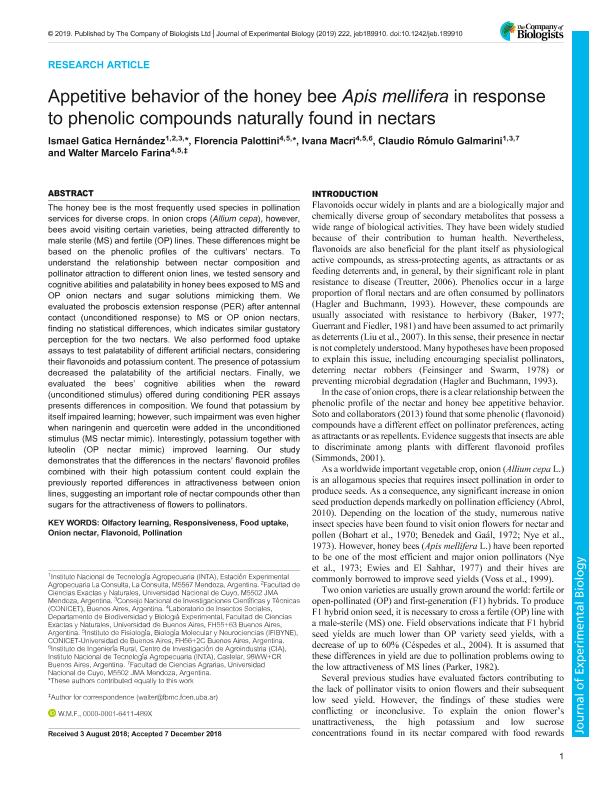Mostrar el registro sencillo del ítem
dc.contributor.author
Gatica Hernández, Ismaél Jairo Gabriel

dc.contributor.author
Palottini, Florencia

dc.contributor.author
Macri, Ivana Noelia

dc.contributor.author
Galmarini, Claudio Romulo

dc.contributor.author
Farina, Walter Marcelo

dc.date.available
2021-02-19T16:57:27Z
dc.date.issued
2019-01
dc.identifier.citation
Gatica Hernández, Ismaél Jairo Gabriel; Palottini, Florencia; Macri, Ivana Noelia; Galmarini, Claudio Romulo; Farina, Walter Marcelo; Appetitive behavior of the honey bee apis mellifera in response to phenolic compounds naturally found in nectars; Company of Biologists; Journal of Experimental Biology; 222; 2; 1-2019; 1-8
dc.identifier.issn
0022-0949
dc.identifier.uri
http://hdl.handle.net/11336/126099
dc.description.abstract
The honey bee is the most frequently used species in pollination services for diverse crops. In onion crops (Allium cepa), however, bees avoid visiting certain varieties, being attracted differently to male sterile (MS) and fertile (OP) lines. These differences might be based on the phenolic profiles of the cultivars’ nectars. To understand the relationship between nectar composition and pollinator attraction to different onion lines, we tested sensory and cognitive abilities and palatability in honey bees exposed to MS and OP onion nectars and sugar solutions mimicking them. We evaluated the proboscis extension response (PER) after antennal contact (unconditioned response) to MS or OP onion nectars, finding no statistical differences, which indicates similar gustatory perception for the two nectars. We also performed food uptake assays to test palatability of different artificial nectars, considering their flavonoids and potassium content. The presence of potassium decreased the palatability of the artificial nectars. Finally, we evaluated the bees’ cognitive abilities when the reward (unconditioned stimulus) offered during conditioning PER assays presents differences in composition. We found that potassium by itself impaired learning; however, such impairment was even higher when naringenin and quercetin were added in the unconditioned stimulus (MS nectar mimic). Interestingly, potassium together with luteolin (OP nectar mimic) improved learning. Our study demonstrates that the differences in the nectars’ flavonoid profiles combined with their high potassium content could explain the previously reported differences in attractiveness between onion lines, suggesting an important role of nectar compounds other than sugars for the attractiveness of flowers to pollinators.
dc.format
application/pdf
dc.language.iso
eng
dc.publisher
Company of Biologists

dc.rights
info:eu-repo/semantics/openAccess
dc.rights.uri
https://creativecommons.org/licenses/by-nc-sa/2.5/ar/
dc.subject
FLAVONOID
dc.subject
FOOD UPTAKE
dc.subject
OLFACTORY LEARNING
dc.subject
ONION NECTAR
dc.subject
POLLINATION
dc.subject
RESPONSIVENESS
dc.subject.classification
Zoología, Ornitología, Entomología, Etología

dc.subject.classification
Ciencias Biológicas

dc.subject.classification
CIENCIAS NATURALES Y EXACTAS

dc.title
Appetitive behavior of the honey bee apis mellifera in response to phenolic compounds naturally found in nectars
dc.type
info:eu-repo/semantics/article
dc.type
info:ar-repo/semantics/artículo
dc.type
info:eu-repo/semantics/publishedVersion
dc.date.updated
2020-11-09T19:21:41Z
dc.journal.volume
222
dc.journal.number
2
dc.journal.pagination
1-8
dc.journal.pais
Reino Unido

dc.journal.ciudad
Cambridge
dc.description.fil
Fil: Gatica Hernández, Ismaél Jairo Gabriel. Universidad Nacional de Cuyo; Argentina. Consejo Nacional de Investigaciones Científicas y Técnicas; Argentina. Instituto Nacional de Tecnología Agropecuaria. Centro Regional Mendoza-San Juan. Estación Experimental Agropecuaria La Consulta; Argentina
dc.description.fil
Fil: Palottini, Florencia. Consejo Nacional de Investigaciones Científicas y Técnicas. Oficina de Coordinación Administrativa Ciudad Universitaria. Instituto de Fisiología, Biología Molecular y Neurociencias. Universidad de Buenos Aires. Facultad de Ciencias Exactas y Naturales. Instituto de Fisiología, Biología Molecular y Neurociencias; Argentina. Universidad de Buenos Aires. Facultad de Ciencias Exactas y Naturales. Departamento de Biodiversidad y Biología Experimental. Laboratorio del Grupo de Estudio de Insectos Sociales; Argentina
dc.description.fil
Fil: Macri, Ivana Noelia. Consejo Nacional de Investigaciones Científicas y Técnicas. Oficina de Coordinación Administrativa Ciudad Universitaria. Instituto de Fisiología, Biología Molecular y Neurociencias. Universidad de Buenos Aires. Facultad de Ciencias Exactas y Naturales. Instituto de Fisiología, Biología Molecular y Neurociencias; Argentina. Universidad de Buenos Aires. Facultad de Ciencias Exactas y Naturales. Departamento de Biodiversidad y Biología Experimental. Laboratorio del Grupo de Estudio de Insectos Sociales; Argentina. Instituto Nacional de Tecnologia Agropecuaria. Centro de Investigacion de Agroindustria. Instituto de Ingeniería Rural.; Argentina
dc.description.fil
Fil: Galmarini, Claudio Romulo. Universidad Nacional de Cuyo; Argentina. Consejo Nacional de Investigaciones Científicas y Técnicas. Centro Científico Tecnológico Conicet - Mendoza; Argentina. Instituto Nacional de Tecnología Agropecuaria. Centro Regional Mendoza-San Juan. Estación Experimental Agropecuaria La Consulta; Argentina
dc.description.fil
Fil: Farina, Walter Marcelo. Universidad de Buenos Aires. Facultad de Ciencias Exactas y Naturales. Departamento de Biodiversidad y Biología Experimental. Laboratorio del Grupo de Estudio de Insectos Sociales; Argentina. Consejo Nacional de Investigaciones Científicas y Técnicas. Oficina de Coordinación Administrativa Ciudad Universitaria. Instituto de Fisiología, Biología Molecular y Neurociencias. Universidad de Buenos Aires. Facultad de Ciencias Exactas y Naturales. Instituto de Fisiología, Biología Molecular y Neurociencias; Argentina
dc.journal.title
Journal of Experimental Biology

dc.relation.alternativeid
info:eu-repo/semantics/altIdentifier/url/https://jeb.biologists.org/content/222/2/jeb189910
dc.relation.alternativeid
info:eu-repo/semantics/altIdentifier/doi/http://dx.doi.org/10.1242/jeb.189910
Archivos asociados
